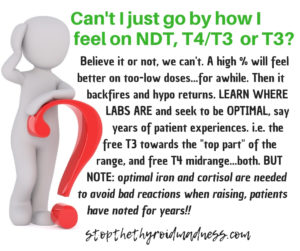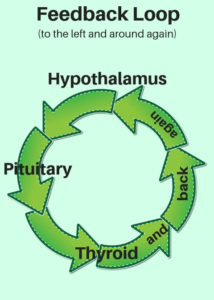 Did you know there is a messaging called the feedback loop that takes place in your body as related to your thyroid?
Did you know there is a messaging called the feedback loop that takes place in your body as related to your thyroid?
The thyroid, as an Endocrine gland, has to be messaged to do its work. This messaging is called the Hypothalamic-pituitary-thyroid axis, also called the feedback loop. It occurs from the hypothalamus, to the pituitary, to the thyroid…and back again. It’s a messaging process that’s always seeking an equilibrium–meaning the right amount of circulating thyroid hormones in your body at any given time
PART ONE OF THE FEEDBACK LOOP — the hypothalamus
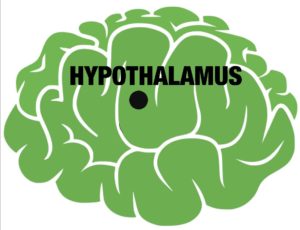
It all starts with a tiny gland in your brain called the Hypothalamus. It’s the Wizard of Oz of your body–sensing behind the scenes as to what’s going on. So in a healthy body, if the body needs more thyroid hormones, it knows it! So what does it do? It will release a messenger hormones towards the pituitary called the TRH (Thyrotrophin-releasing hormone).
PART TWO OF THE FEEDBACK LOOP — the pituitary
The pituitary, another tiny gland in the brain region, is right below the hypothalamus. When 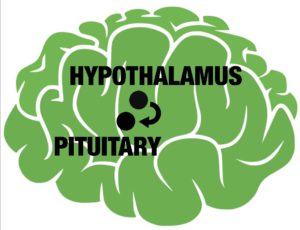 the hypothalamus releases the TRH towards the pituitary, the pituitary then releases another messenger hormone to go directly to the thyroid, called the TSH (thyroid stimulating hormone).
the hypothalamus releases the TRH towards the pituitary, the pituitary then releases another messenger hormone to go directly to the thyroid, called the TSH (thyroid stimulating hormone).
PART THREE OF THE FEEDBACK LOOP — the TSH to the thyroid
Yes, your thyroid gland doesn’t just produce thyroid hormones and release them on its own accord. It has to be stimulated by the TSH messenger hormone which is sent by the pituitary! And this stimulation causes the thyroid to release thyroid hormones like T4, T3, etc. And this release of thyroid hormones inhibits the TSH and TRH, and 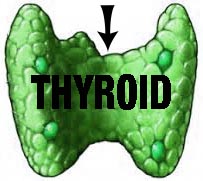 eventually it all starts all over again once the hormones are used and the body is in need of more thyroid hormones. THE LOOP.
eventually it all starts all over again once the hormones are used and the body is in need of more thyroid hormones. THE LOOP.
So what does “suppression of the feedback loop” mean??
Thyroid meds, even those low starting doses, appear to start suppressing/toning down the feedback loop messaging. It’s as if the hypothalamus senses the addition of thyroid hormones, and thus isn’t going to start the messaging process as strongly. So at this point, on low doses, we are suppressing more than replacing.
But we’ve learned the hard way that to the degree we start toning down the feedback loop, we also need to find the amount of thyroid meds that gives us back what we need–that equilibrium of replacing more than suppressing. Low doses don’t give back what we need, and are still suppressing what little we may be releasing as it is.
So what what happens when we “suppress” more than “replace”?? Our hypothyroidism can return with a vengeance. The individuality is when it was return with a vengeance.
We even may be seeing this “suppression more than replacing” phenomena with the least effective of treatments for what appears to be the majority: T4-only.
The solution to all this?
Patients learned to find their optimal dose of thyroid meds. It appears for most, and based on years of patient observations and reports, the optimal dose of a working NDT and T4/T3 will put the free T3 towards the top part of the range and the free T4 midrange. BOTH. The optimal dose of T3-only seems to consistently put the free T3 at the top part of the range. For some, even slightly over. It’s very individual.
But when I try to get optimal on NDT, T4/T3 or T3, I have problems.
Having problems when raising (to overcome the normal suppression of the feedback loop) is usually due to these reasons, say years of reports:
1) Having low cortisol–can cause heart palps, fast heartrate anxiety, pooling or a variety of overreactions when raising.
2) Rising RT3, the inactive hormone–we tend to feel more hypo when this is happening. Can be from inadequate levels of iron, high iron, high cortisol, inflammation, viral or bacterial infections, Lyme, mold inhalation….etc. We test to find out, then treat!!
https://stopthethyroidmadness.com/adrenal-info
https://stopthethyroidmadness.com/reverse-T3
Can there be other issues in this loop?
Yes, but much more rare. One problem can come straight from the hypothalamus and doing a poor job releasing the TRH.1 Another less common problem can be straight from the pituitary, called hypopituitary. But for the majority, the problem in the feedback loop is just underdosing ourselves with our thyroid meds.
Does this feedback loop apply to more than just the thyroid?
Yes! Even the adrenals need to be messaged. i.e. the pituitary should be releasing the ACTH to message the adrenals. Thus, for the majority with a healthy pituitary, if we start on or stay on too low a dose of cortisol, we are suppressing more than replacing. That’s why we do our Daily Average Temps to find the right amount. Study Chapters 5 and 6 to understand this in the revised STTM book.
More reading:
https://www.ncbi.nlm.nih.gov/pmc/articles/PMC8315115/
FOOTNOTES:
- https://www.ncbi.nlm.nih.gov/pubmed/6432893
Important notes: All the information on this website is copyrighted. STTM is an information-only site based on what many patients worldwide have reported in their treatment and wisdom over the years. This is not to be taken as personal medical advice, nor to replace a relationship with your doctor. By reading this information-only website, you take full responsibility for what you choose to do with the information on STTM or its outcomes. See the Disclaimer and Terms of Use.

